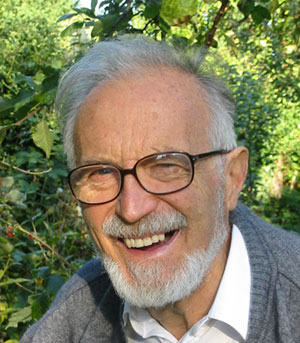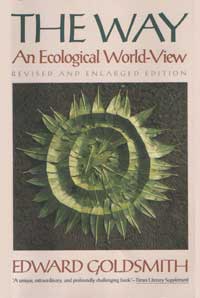Green Party UK co-founder Teddy Goldsmith passes at 80
Share
 by Mike Feinstein, member, International Committee of the Green Party of the United States
by Mike Feinstein, member, International Committee of the Green Party of the United States
 Founding editor of The Ecologist Magazine in 1972 and a co-founder of the Green Party in the United Kingdom, Teddy Goldsmith passed away on August 21, 2009 at age 80. The elder brother of billionaire Sir James Goldsmith, Goldsmith was a champion of conservation and organic farming, a†passionate campaigner for the rights of indigenous people, and an early proponent for a steady state economy.
Founding editor of The Ecologist Magazine in 1972 and a co-founder of the Green Party in the United Kingdom, Teddy Goldsmith passed away on August 21, 2009 at age 80. The elder brother of billionaire Sir James Goldsmith, Goldsmith was a champion of conservation and organic farming, a†passionate campaigner for the rights of indigenous people, and an early proponent for a steady state economy.
In January 1972, Goldsmith published A Blueprint for Survival, in advance of the world’s first ever Environment Summit: the 1972 UN Conference on the Human Environment, in Stockholm. Occupying all of The Ecologist Vol. 2 No.1, the tract is one of the most influential in the history of the green movement. So great was the initial response that Blueprint was quickly republished in paperback by Penguin books in September 1972, ultimately selling over 750,000 copies in 17 languages, influencing politicians, economists and others for years to come.
 Among those influenced were a small group of young English environmentalists, who had been meeting since the summer of 1972 to discuss the ecological crisis. On March 19th, 1973 they gathered for a meeting of more than 50 people In the West Midlands city of Coventry and founded the first Green Party in the UK. They chose PEOPLE as the party’s name and approved an initial program based upon on the four principles the Blueprint for Society offered as the ëprincipal conditions for a stable societyí:
Among those influenced were a small group of young English environmentalists, who had been meeting since the summer of 1972 to discuss the ecological crisis. On March 19th, 1973 they gathered for a meeting of more than 50 people In the West Midlands city of Coventry and founded the first Green Party in the UK. They chose PEOPLE as the party’s name and approved an initial program based upon on the four principles the Blueprint for Society offered as the ëprincipal conditions for a stable societyí:
1) minimum disruption of ecological processes
2) maximum conservation of materials and energy
3) a population in which recruitment equals loss
4) a social system in which individuals can enjoy, rather than feel restricted by the first three conditions.
To help PEOPLE get off the ground, Goldsmith contributed the mailing list from the Movement for Survival. Then in the February 1974 general election, he stood as the PEOPLE party candidate at Eye, Suffolk. Deciding he needed a gimmick to gain attention for his issues, Goldsmith and supporters paraded with a camel through the local streets that he borrowed from a local private zoo, bearing the slogan “No Deserts in Suffolk. Vote Goldsmith” in order to highlight the issue of intensive farming and soil erosion in East Anglia. In the late 1970s he focused on opposing nuclear power in England and in 1979 contested Cornwall and Plymouth in the European parliamentary election for the Ecology Party, which was the new name for PEOPLE after it changed its name in 1975
In the 1980s Goldsmith directed some of his fiercest attacks towards the policies of World Bank, which he saw as financing illusory progress by forcing developing countries to export food while destroying their natural ability to grow it. After visiting valleys in Sri Lanka about to be flooded for hydroelectric dams, Goldsmith began researching the impact of large dams. Working with Nicholas Hildyard, the result was his three-volume study The Social and Environmental Effects of Large Dams (1984-92), now the standard work on the subject. In recognition of this work, the government of Francois Mitterand appointed him a Chevalier of the LÈgion d’honneur in 1991. Around the same time, he presented a three-million-signature petition to the United Nations, calling for an emergency debate on the fate of the world’s rainforests.
 In 1992 Goldsmith published The Way: An Ecological World View, his philosophical magnum opus and a culmination and synthesis of more than four decades of theoretical development embodying a “coherent worldview”. Well know international Greens like Arne Naess, Charlene Spretnak, Herman Daly, Jerry Mander and Bill McKibben wrote testimonials for the books back and inside cover, with Manderís praise typical, saying ìGoldsmith articulates a new comprehensive point-by-point blueprint for the radical changes in human thinking and in our systems of organization, that stand a chance to sustain life on Earth. Anyone interested in charting the planetís survival must read this vital work.
In 1992 Goldsmith published The Way: An Ecological World View, his philosophical magnum opus and a culmination and synthesis of more than four decades of theoretical development embodying a “coherent worldview”. Well know international Greens like Arne Naess, Charlene Spretnak, Herman Daly, Jerry Mander and Bill McKibben wrote testimonials for the books back and inside cover, with Manderís praise typical, saying ìGoldsmith articulates a new comprehensive point-by-point blueprint for the radical changes in human thinking and in our systems of organization, that stand a chance to sustain life on Earth. Anyone interested in charting the planetís survival must read this vital work.
Yet Goldsmith had his critics. As The Economist noted back in 1999, Goldsmith ìhas never brooked any compromise with governments and big business; the ëpolicy-wonkingí has been left to his more emollient successors such as Jonathan Porritt of Friends of the Earth. Unlike the vast majority of his fellow campaigners, he is also well to the right of the Conservative Party on social and moral issues. This has made him an acquired taste even within the environmental movement. He has recently lost one editor of the Ecologist magazine, Nicholas Hildyard, for precisely these reasons.î Referring to that same incident, journalist George Monbiot recalls ìThe previous editorial team split with Goldsmith after he addressed a meeting of the hard right Groupement de Recherche et díEtudes pour la Civilisation Europeene. Goldsmith, whose politics are a curious mixture of radical and reactionary, has advocated the enforced separation of Tutsis and Hutus in Rwanda and Protestants and Catholics in Ulster, on the grounds that they constitute ëdistinct ethnic groupsí and are thus culturally incapable of co-habitation.î
But Porritt said he probably wouldnít have first joined the Green Party if he hadnít read Blueprint for Survival in 1972 and probably wouldnít have stuck with the party ìwere it not for the radicalism and intellectual integrity of the Ecologist magazine.î He observed that ìthe obituaries have wrestled with the difficulty of placing Teddy on any conventional political spectrum ñ which is a fairly crazy thing to want to do anyway. He could be withering about every political persuasion, and seriously loved getting people worked up as he challenged their complacent orthodoxies. Was he intolerant? Not particularly. Xenophobic or even racist? Absolutely not. He just advocated a particular kind of uncompromising sustainability that inevitably made things uncomfortable for friends and foes alike. And thank God for that.î
Upon his passing, the Green Party of England and Wales said that Goldsmith ìwas a colourful and controversial character. Although at times his views strongly diverged from those of the party he played such a key role in helping to found, he was a real pioneer of the Green movement and will be sorely missed.”
For more information: www.edwardgoldsmith.com
In January 1972, Goldsmith published†A Blueprint for Survival Ö the tract is one of the most influential in the history of the green movement.




